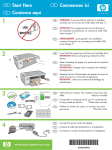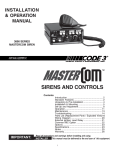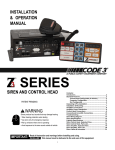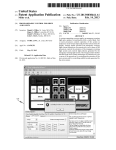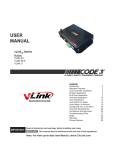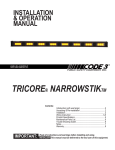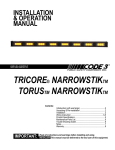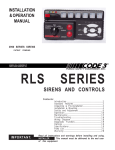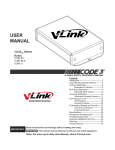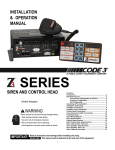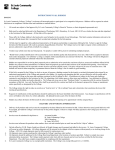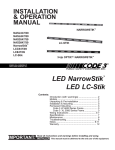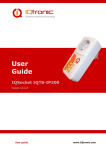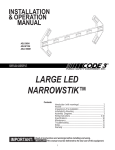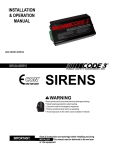Download and view
Transcript
INSTALLATION & OPERATION MANUAL LFAMP SECONDARY ACOUSTICAL WARNING DEVICE LFAMP Contents: Introduction ........................................................ 2 Standard Features.............................................. 2 Unpacking & Pre-Installation .............................. 3 Installation & Mounting ....................................... 4 Set-Up and Adjustment ...................................... 4 Operation ............................................................ 4 Maintenance ....................................................... 4 Specifications ..................................................... 5 Wiring Diagram .................................................. 5 Troubleshooting ................................................. 6 Warranty ............................................................. 8 I M P O R TA N T: Read all instructions and warnings before installing and using. INSTALLER This manual must be delivered to the end user of this equipment. Introduction The LFAMP is intended for use as a Secondary Acoustical Warning Device for use with your standard Code 3 siren. The LFAMP generates a penetrating low frequency tone which, when used in conjunction with your standard Code 3 siren, may help to alert others to the approach of an emergency vehicle. The LFAMP should be used only in conjunction with the normal operation of your standard Code 3Ò siren. The standard siren must be used as your primary acoustical warning device. ! WARNING! The LFAMP is intended for use as a secondary acoustical warning device only. The LFAMP Secondary Acoustical Warning Device does not meet the requirements of SAE J1849 and California Title 13. The LFAMP must be installed in addition to an approved Code 3Ò siren system, otherwise the vehicle may not comply with state and local regulations. • This siren is not a substitute for a compliant siren. • This siren must be used in conjunction with a siren that meets local regulations. • Consult your local regulations to ensure compliance. • This siren, when used in conjunction with a compliant siren extends the range of frequencies broadcasted, improving warning effectiveness. Standard Features The LFAMP Secondary Acoustical Warning Device consists of a remotely mounted amplifier which is activated by the InterClear® output of your Code 3 siren. The following features are standard in the LFAMP Secondary Acoustical Warning Device: Instant-On- There is no " ON/OFF " switch. When installed in accordance with this manual, the device will operate automatically when the InterClear® output of the primary siren is active. Refer to the primary siren's User Manual for detailed information on the operation of the InterClear® output. ! WARNING! All devices should be mounted in accordance with the manufacturer’s instructions and securely fastened to vehicle elements of sufficient strength to withstand the forces applied to the device. Ease of operation and convenience to the operator should be the prime consideration when mounting the siren and controls. Adjust the mounting angle to allow maximum operator visibility. Do not mount the Control Head Module in a location that will obstruct the drivers view. Mount the microphone clip in a convenient location to allow the operator easy access. Devices should be mounted only in locations that conform to their SAE identification code as described in SAE Standard J1849. For example, electronics designed for interior mounting should not be placed underhood, etc. Controls should be placed within convenient reach* of the driver or if intended for two person operation the driver and/or passenger. In some vehicles, multiple control switches and/or using methods such as “horn ring transfer” which utilizes the vehicle horn switch to toggle between siren tones may be necessary for convenient operation from two positions. 2 2 Status LEDs - A green indicator LED, visible on the front of the LFAMP, indicates that the device is on when lighted. The green LED will be lighted only when the REMOTE input is active (+12VDC). A red indicator LED indicates that the LFAMP is in protect mode due to a fault condition such as over heating due to a shorted speaker or speaker wires. Remote Switching - The LFAMP Secondary Acoustical Warning Device requires a positive signal from the primary siren's InterClear® output to remotely activate the low frequency tone. Unpacking & Pre-installation After unpacking your LFAMP Secondary Acoustical Warning Device, carefully inspect the unit and associated parts for any damage that may have been caused in transit. Report any damage to the carrier immediately. Figure 1, LFAMP Sirens are an integral part of an effective audio/visual emergency warning system. However, sirens are only short range secondary warning devices. The use of a siren does not insure that all drivers can or will observe or react to an emergency warning signal, particularly at long distances or when either vehicle is traveling at a high rate of speed. Sirens should only be used in a combination with effective warning lights and never relied upon as a sole warning signal. Never take the right of way for granted. It is your responsibility to be sure you can proceed safely before entering an intersection, driving against traffic, or responding at a high rate of speed. The effectiveness of this warning device is highly dependent upon correct mounting and wiring. Read and follow the manufacturer’s instructions before installing or using device. The vehicle operator should check the equipment daily to insure that all WARNING! this features of the device operate correctly. SIREN PRODUCTS: To be effective, sirens must produce high sound levels that potentially can inflict hearing damage. Installers should be warned to wear hearing protection, clear bystanders from the area and not to operate the siren indoors during testing. Vehicle operators and occupants should assess their exposure to siren noise and determine what steps, such as consultation with professionals or use of hearing protection should be implemented to protect their hearing. This equipment is intended for use by authorized personnel only. It is the user’s responsibility to understand and obey all laws regarding emergency warning devices. The user should check all applicable city, state and federal laws and regulations. Code 3, Inc., assumes no liability for any loss resulting from the use of this warning device. Proper installation is vital to the performance of the siren and the safe operation of the emergency vehicle. It is important to recognize that the operator of the emergency vehicle is under psychological and physiological stress caused by the emergency situation. The siren system should be installed in such a manner as to: A) Not reduce the acoustical performance of the system, B) Limit as much as practical the noise level in the passenger compartment of the vehicle, C) Place the controls within convenient reach of the operator so that he can operate the system without losing eye contact with the roadway. Emergency warning devices often require high electrical voltages and/or currents. Properly protect and use caution around live electrical connections. Grounding or shorting of electrical connections can cause high current arcing, which can cause personal injury and/or severe vehicle damage, including fire. PROPER INSTALLATION COMBINED WITH OPERATOR TRAINING IN THE PROPER USE OF EMERGENCY WARNING DEVICES IS ESSENTIAL TO INSURE THE SAFETY OF EMERGENCY PERSONNEL AND THE PUBLIC. ! 3 Installation & Mounting The LFAMP Secondary Acoustical Warning Device may be mounted in the trunk or a console near the primary siren. Ease of operation and convenience to the operator should be the prime consideration when mounting the primary siren and controls. Amplifier Connections LFAMP Connectors - As a standard feature, the LFAMP comes equipped with screw terminal connectors. To terminate the wires, strip approximately 1/4" of insulation from the end of each wire and insert it beneath the appropriate screw in the terminal block. Tighten the screw and proceed to the next connection. Terminal Block Connections (See Figure 2) + Bridged Mode - Connect to the wire from terminal 1 of the Code 3 C3100LF speaker. - Bridged Mode - Connect to the wire from terminal 2 of the Code 3 C3100LF speaker. REMOTE - Connect the Remote terminal directly to the InterClear® output of your Code 3 siren. +12V- Connect to the positive power source through a 15A fuse. This supplies +12VDC power to the LFAMP. Use #14 gauge wire. GND- Connect to the negative terminal of the battery. This supplies ground (earth) to the LFAMP. Use #14 gauge wire. SETUP AND ADJUSTMENT No setup and adjustments are required for the LFAMP Secondary Acoustical Warning Device. Function Description The LFAMP Secondary Acoustical Warning Device will generate the low frequency secondary acoustical warning tone when the Remote input is active. MAINTENANCE Your Code 3® LFAMP Secondary Acoustical Warning Device has been designed to provide trouble free service. In case of difficulty, see Troubleshooting (page 6). Also check for shorted or open wires. The primary cause of short circuits has been found to be wires passing through firewalls, roofs, etc. If further difficulty persists, contact the factory for troubleshooting advice or return instructions. Public Safety Equipment, Inc. maintains a complete parts inventory and service facility at the factory and will repair or replace (at the factory's option) any unit found to be defective under normal use and in warranty. Any attempt to service a unit in warranty by anyone other than a factory authorized technician without express written consent by the factory, will void the warranty. Units out of warranty can be repaired at the factory for a nominal charge on either a flat rate or parts and labor basis. Contact the factory for details and return instructions. Public Safety Equipment, Inc. is not liable for any incidental charges related to the repair or replacement of a unit unless otherwise expressly agreed to in writing. 4 Specifications Input Voltage - 10.5 to 16 VDC, negative ground (earth) Operating Current 100W: 15A Peak @ 13.6V with one 11-ohm load* Power: 100W / 200W Peak (1 or 2 C3100 Speakers)* Duty Cycle: 50% (Max continuous on time - 60 seconds). Voltage Output ( approx. ) 64 V peak-to-peak Weight: 4.4 lbs (2 Kg) Size: - 10.5" L x 6.0" W x 2.5" H Temperature: -22°F - +149°F (-30°C - +65°C) SAE Equipment Type EVS1 * The LFAMP requires the use of special Code 3® C3100LF speakers. Do not use standard siren speakers. Figure 2, Wiring Diagram, Typical Connections for RLS Amplifier Shown 5 TROUBLESHOOTING (Refer to wiring diagram page 5) PROBLEM PROBABLE CAUSE REMEDY A. REMOTE INPUT NOT CONNECTED OR NOT ACTIVE. B. BLOWN FUSE OR POWER NOT CONNECTED. C. BAD SPEAKER OR WIRES OR LFAMP IN PROTECT MODE. A. AMPLIFIER POWER WIRES REVERSED POLARITY B. AMPLIFIER OVERLOADED A. CHECK WIRING. B. CHECK FUSE AND POWER WIRING C. CHECK SPEAKER AND WIRING. CHECK RED PROTECT LED A. CHECK POLARITY B. CHECK WIRING AND SPEAKERS NO OUTPUT FROM SPEAKER. A. SPEAKER NOT CONNECTED/ OPEN CIRCUIT IN SPEAKER WIRING B. DEFECTIVE SPEAKERS SIREN TONES VOLUME TOO LOW/GARBLED. A. LOW VOLTAGE TO SIREN AMPLIFIER B. HIGH RESISTANCE IN WIRING/ DEFECTIVE SPEAKER C. SPEAKERS PHASED IMPROPERLY INTERCLEAR WILL NOT POWER AUXILIARY DEVICES. A. THERE IS A SHORT IN THE WIRING, OR THE LOAD IS GREATER THAN 1 A. A. CHECK SPEAKER WIRING B. REPLACE SPEAKER(S) A. CHECK WIRING FOR BAD CONNECTIONS/ CHECK VEHICLE CHARGING SYSTEM B. CHECK SPEAKER(S) WIRING/REPLACE SPEAKER(S) C. REFER TO PAGE 5 FOR PROPER PHASING (200W OPTION) A. CHECK FOR SHORTS. INSTALL INTERCLEAR BOOSTER KIT (PART #INTBS) NO LFAMP OUTPUT. EXTERNAL 15A FUSE BLOWS. 6 NOTES 7 WARRANTY Code 3, Inc.'s emergency devices are tested and found to be operational at the time of manufacture. Provided they are installed and operated in accordance with manufacturer's recommendations, Code 3, Inc. guarantees all parts and components except the lamps to a period of 1 year (unless otherwise expressed) from the date of purchase or delivery, whichever is later. Units demonstrated to be defective within the warranty period will be repaired or replaced at the factory service center at no cost. Use of lamp or other electrical load of a wattage higher than installed or recommended by the factory, or use of inappropriate or inadequate wiring or circuit protection causes this warranty to become void. Failure or destruction of the product resulting from abuse or unusual use and/or accidents is not covered by this warranty. Code 3, Inc. shall in no way be liable for other damages including consequential, indirect or special damages whether loss is due to negligence or breach of warranty. CODE 3Ò, INC. MAKES NO OTHER EXPRESS OR IMPLIED WARRANTY INCLUDING, WITHOUT LIMITATION, WARRANTIES OF FITNESS OR MERCHANTABILITY, WITH RESPECT TO THIS PRODUCT. PRODUCT RETURNS If a product must be returned for repair or replacement*, please contact our factory to obtain a Return Goods Authorization Number (RGA number) before you ship the product to Code 3, Inc. Write the RGA number clearly on the package near the mailing label. Be sure you use sufficient packing materials to avoid damage to the product being returned while in transit. *Code 3, Inc. reserves the right to repair or replace at its discretion. Code 3, Inc. assumes no responsibility or liability for expenses incurred for the removal and /or reinstallation of products requiring service and/or repair.; nor for the packaging, handling, and shipping: nor for the handling of products return to sender after the service has been rendered. For Technical Support / Service, please call 314-996-2800. CODE 3Ò, Inc. 10986 N. Warson Road St. Louis, Missouri 63114-2029—USA Ph. (314) 426-2700 Fax (314) 426-1337 www.code3pse.com Code 3, Inc. is a registered trademark of Public Safety Equipment, Inc. 8 Revision 0, 06/06- Instruction Book Part No. 11437 ©2006, Public Safety Equipment, Inc. Printed in USA









